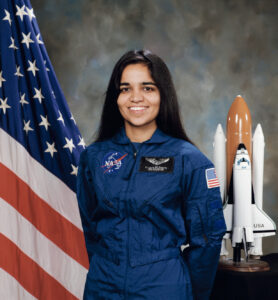32 Kalpana Chawla
Kalpana Chawla |
 |
Time period:1984 – 2003 Subject:Aerospace Engineering |
|
Biography:Kalpana was born on March 17, 1962 in Haryana, India. She was a Punjabi Hindu woman who was born into a very conservative society but broke many traditions as she became the first female Indian astronaut. As a child, Kalpana developed an interest in flying after first seeing a plane at the age of three. While obtaining an aeronautical engineering degree from Punjabi Engineering College, her professors tried to dissuade her, as there were limited opportunities for girls in India following this career path. However, Chawla was adamant that this was the subject for her. She graduated with her bachelors and eventually moved to the United States in 1982. She eventually obtained a master’s degree in Aerospace Engineering from the University of Texas at Arlington in 1984. She also earned a second master’s degree in 1986 and a PhD in aerospace engineering in 1988 from the university of Colorado Boulder. Kalpana started working at NASA’s Ames Research Center that same year and in 1994 she was selected as an astronaut candidate. Kalpana felt very passionately about providing science education opportunities for young girls in India. Therefore, while she worked at NASA, they invited Kalpana’s secondary school to take part in their Summer Space Experience Program. Kalpana’s first flight took place on November 19, 1997. She was on board the Space Shuttle Columbia as part of STS-87. Chawla was tasked with operating the robotic arm, which she used to deploy the Spartan Satellite. During this mission, the crew oversaw numerous experiments, with a focus on materials science. Once again, as part of STS-87, Kalpana launched on board Space Shuttle Columbia, on January 16, 2003. During this mission, Kalpana oversaw microgravity experiments on crystal growth, combustion and fire suppression, as well as prostate cancer. However, Kalpana and six other crew members were tragically killed as the shuttle broke during re-entry on February 1, 2003. Kalpana was posthumously awarded the Congressional Space Medal Honour.
|
|
Summary of their contributions:Kalpana Chawla used her skills to study how simulations of complex air flows around aircrafts. She also worked on making airplanes more efficient and worked on simulations of moving multiple body problems. Her work helped improve our understanding of aerodynamics, which is crucial for designing safer and more efficient aircraft. She also carried out a number of experiments during her space flights. This included studying plant reproduction in microgravity and how materials behave in space. The microgravity environment of space provides a platform for studying the effects of weightlessness on living organisms. Kalpana’s involvement in experiments related to biological studies helped scientists explore how microgravity influences the growth, development, and behavior of organisms. This research has implications for understanding human health and the potential challenges of long-duration space travel. |
|
Integration with the BC Secondary Science Curriculum:Kalpana Chawla’s story could easily be integrated into the BC Science curriculum. Her experience as an astronaut would align well in the Science 10 curriculum. Especially in regard to the following content learning standards: big bang theory The story of Kalpana Chawla could easily be integrated into the science 10 earth science unit. As students learn about the components of the universe, they may be inspired to pursue careers in space exploration. Kalpana’s career could be highlighted during this unit to further motivate minority students to pursue such endeavors.
|
|
References:Harvey, A., & Tillman, T, N. (2022, February 20). Kalpana Chawla: Biography & Columbia disaster. Space.com. https://www.space.com/17056-kalpana-chawla-biography.html Margolis, A., E. (2023, February 1). Kalpana Chawla: The First South Asian American Woman in Space. National Air and Space Museum. https://airandspace.si.edu/stories/editorial/kalpana-chawla Wong, M. (n.d) Kalpana Chawla. University of Toronto, Science Communication Club. https://scc.sa.utoronto.ca/content/kalpana-chawla/ Wright, P (2003, February 3). Kalpana Chawla. The Guardian. https://www.theguardian.com/science/2003/feb/03/spaceexploration.columbia5 https://www.theguardian.com/science/2003/feb/03/spaceexploration.columbia5 |
|

